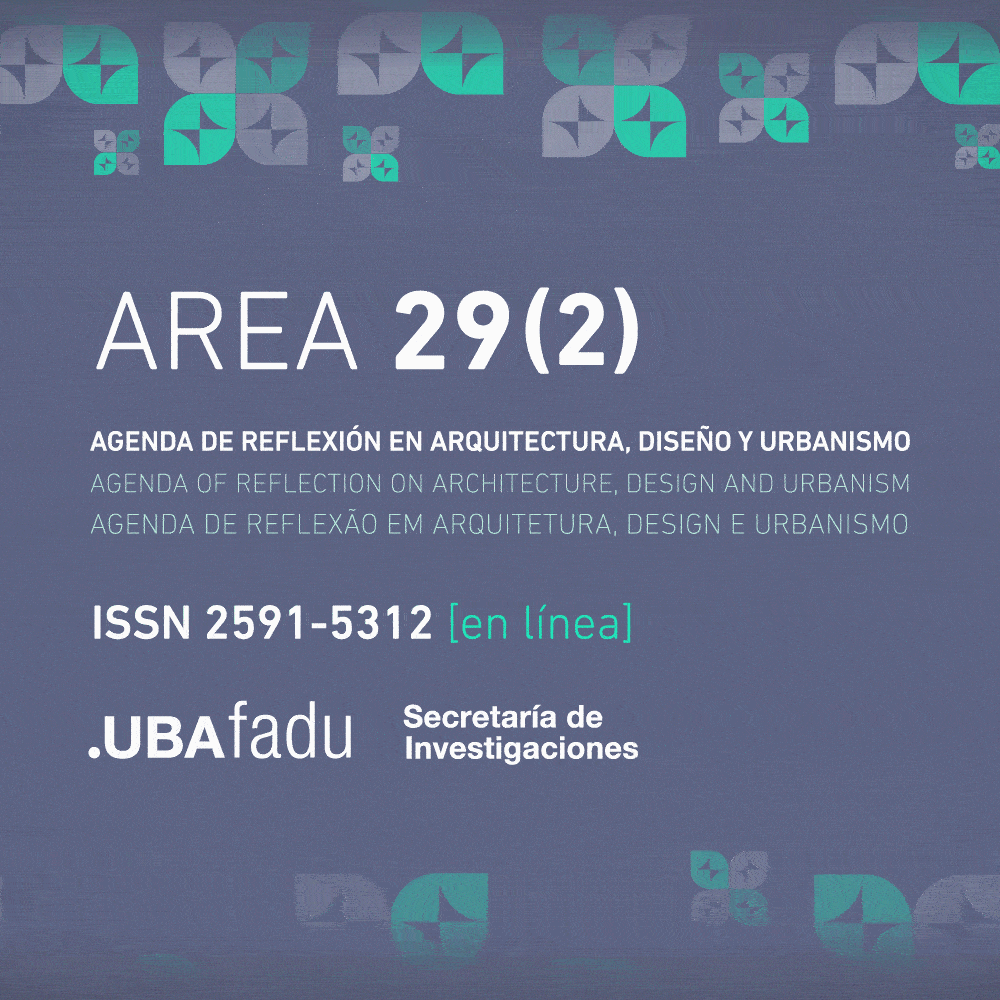
MAY 2023 / OCTOBER 2023
Director: Dra. Arq. Rita Laura Molinos
Editor: Dra. María Ledesma
Coeditor: DG. Miguel A. Santángelo
Technical editor: DG. Emiliano M. Eseiza
© The contents and metadata of this magazine are licensed under Open Access CC BY-NC-ND 2.5 AR
DNDA registration of the digital edition in process

Contents
General thematic articles
Organizationisms
Santiago Miret
Abstract
Organizationisms focuses on the problem of geometric rigor in the study of the form of paradigmatic architectural projects, in order to find in them the elements, relationships and behaviours that determine them as singular formal systems. Emphasizing the precision of geometric construction through the use of digital platforms in progressive instances of complexity. The construction of models and their parameterization is a means for the development of precise organizations and formal configurations that escape strictly functional or tectonic criteria and focus on the relationship between the elements that compose them. The objective is the practical and argumentative construction of complex configurations emerging from formal variations of architectural case studies, in order to build precise evaluation frameworks regarding their organization in terms of form and geometric behaviour. We avoid procedures linked to functional aspects and focus on the configuration of formal organizations based on the construction of models according to instances of variable relationality. In this way, the construction of a singular regulation of the geometric model is sought, with the purpose of building instances of variability that derive in new projects.
Homeless people. Social networks, spacial capital, and daily life. City of Buenos Aires 2017-2023
Verónica Paiva
Abstract
The objective of this article is to analyse the case of homeless people in the city of Buenos Aires, given that in recent years there has been a significant increase in this population sector. According to censuses of civil organizations, in 2017 there were 4,394 homeless people, of which 23% had entered that state in the last year. Two years later, in April 2019, the existence of 7,251 homeless people confirmed, of which 52% said it was the first time they had been on the street. According to these data, the article investigates the following aspects: what characteristics have homeless people? How does spatial capital affect the production of your daily life? Does the street situation propose a different way of inhabiting the city than those usually considered by architecture and urbanism? The methodology used is qualitative, centrally interviews carried out on the street, and in churches where people go to sanitize or eat. The article contributes to social and urban studies related to people who are homeless, since it addresses how they live and survive on the street, what networks they use and how space capital serves them in their daily lives.
Composted faces. Masks and symbionts in response to surveillance and state violence
Adriana Castrillón Arango
Abstract
This article describes the reflections of the Compost Faces workshops, a series of speculative fabulation sessions exploring the actions of care required in contexts of state violence and environmental deterioration, intensified day to day. In the Compost Faces workshops, fabulative narratives and masks were created to speculate on the need to anonymize the actions of individuals who have been historically persecuted and exterminated, due to their participation in processes of social struggle and defense of wounded and at-risk territories. This document interweaves theoretical positions, processes of creation and social activism exposed in the workshops, being the face the mechanism of domination of states, machines and culture, naked, visible and manipulable, but also susceptible to change and performance.
Rural school architecture in its evolution. Four mountain schools in Tucumán, Argentina
Gabriela Soledad Varela Freire
Abstract
This article seeks to analyse how the buildings of rural mountain schools in the province of Tucumán, Argentina, were modified as a result of the implementation of different State policies related to school architecture. For this purpose, an analysis of four schools was used as a starting point, N° 215 in Alto de Anfama-Tafí Viejo, N° 219 in Ancajuli-Tafí Viejo, N° 349 in Ñorco-Trancas, and N° 379 in Lara-Tafí del Valle. Among the main results, it is evident how the overlapping of different State and private decisions modified the architecture of these schools over time.
Pokémon Go’s urban aesthetics. Gamification and connectography in the public spaces of Córdoba city
P. Sebastián Cortez Oviedo
Abstract
The paradigm of the fourth industrial revolution invites us to rethink urban dynamics, particularly the transformations of the cultural appropriation of the city and its public spaces. This paper develops a transdisciplinary debate on the impact of urban mediatization and its techno-cultural dynamics linked to the emerging access, use and social appropriation of public spaces in Córdoba city. It is interested in problematizing the techno-communicative discourses and their incidence in the creation of imaginaries and new spatialities of the public, whose singular experiences are linked to an incipient process of urban gamification. It is an interpretative and processual research that addresses the Pokémon Go phenomenon during the period 2016-2019 and its current projection. The methodology is multimodal, highlighting the triangulation of methods, such as ethnographic and segmented approach.
Hyperprojects. Architectures for a new zeitgeist
Federico Eliaschev
Abstract
The zeitgeist of our time is shown by its mediatized character, that shapes constructing virtual realities and new ways of relating to objects; before inert and now intelligent and interconnected. Is it possible to conceive of architecture as a vector that affects and puts the zeitgeist in crisis? Object-oriented ontology proposes to break with the idea of subject-object correlation to think of it in line with more actant within a world of human and non-human actants. From here also arises the concept of Hyperobject coined by Timothy Morton and the call to activate a cycle of recovery of our planet through this new ontology. The work proposes the category of Hyperproject, as a restorative proposal in the Anthropocene, seeking to avoid the abjection of the disturbing and consequent solidity of the unfolding of reality in virtuality.
Cellular Automata. A new model of participatory design?
Alberto Fernández González
Abstract
Cellular Automata (CA) emerged as a mathematical model in the 1940s, positioning itself as one of the complex systems that can generate forms in 1D, 2D, and 3D. This model is based on the application of bottom-up design principles, where we, as designers, can create basic relationships between each element of the system. This facilitates the emergence of unexpected final results, part of a process of debugging errors in our designs, diverging from the classic top-down methods. To begin, establish a clear definition of “cellular automata.” This term refers to a system that, through computational models, applies a diverse and limited series of rules in a simulated and discrete context, modulating the state of a discrete mesh from an off to on position (0 to 1) in its most elemental expression. This conceptual framework will be fundamental to appreciate the intricate nature and significance of the results that this procedure can produce. Over the years, the CA has established itself as a mathematical simulation system, developing mainly in the digital realm, without explicit physical manifestations in human-scale architecture to date. A CA “seed” can generate a wide set of results, applicable in fields as diverse as biology, medicine, and physics as well as urban studies models, structural and, in general, spatial organization, demonstrating the versatility of the scales at which this model can operate with impressive results. In this article, the CA is explored from its origins, analysing its emergence from a historical perspective as a participatory design approach. Its fundamental principles are described, and how these concepts gradually integrated into the field of architecture, becoming part of our tools and methods for digital design. Additionally, it examines how this progressive adoption has transformed the way we approach design and problem-solving in architecture, answering the central question: Does this represent a new model of participatory design?
Collective housing and variable ownership typological and legal frameworks for the creation of sub functional units
Pablo Alejandro José Ruiz y Romina Lis Garmendia
Abstract
The mechanisms of expansion and reconfiguration within collective housing units face inherent problematics due to their unique nature: the impossibility of volumetric growth due to adjacent units and the constraints imposed by property ownership regulations emerge as the primary challenges to address. While there are also technical construction-related constraints of interest to this research, this stage focuses on the typological and organizational aspects of the floor plan and proposals concerning its legal and regulatory foresight. Through a dual theoretical and propositional approach, this study delineates potential forms of growth, reduction, and reconfiguration of functional units within a broader spectrum of possibilities, while identifying the pertinent aspects within current regulations. Simultaneously, it provides a systematic analysis of previous project experiences from the research, along with a selection of case studies that align with the proposed project strategies. This typological and regulatory approach to the problem serves as a contribution to the need for designing collective housing forms that, without compromising criteria of rationality, resource efficiency, and sustainability, are versatile enough in their initial configuration and potential future changes to meet the ever-increasing and diverse needs of a society that undergoes significant changes in progressively shorter time periods.
Review
Book review. Study the city’s landscape
Jimena Berezovsky
